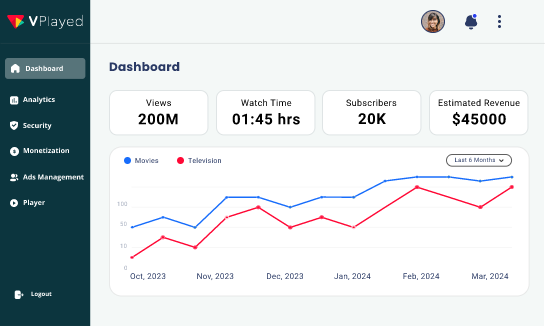Start and Grow Your Online Video Streaming Platform With 1000+ Features & 10+ Revenue Models.
Book a Free DemoWhat Is Video Streaming? Meaning, Definition & How It Works?
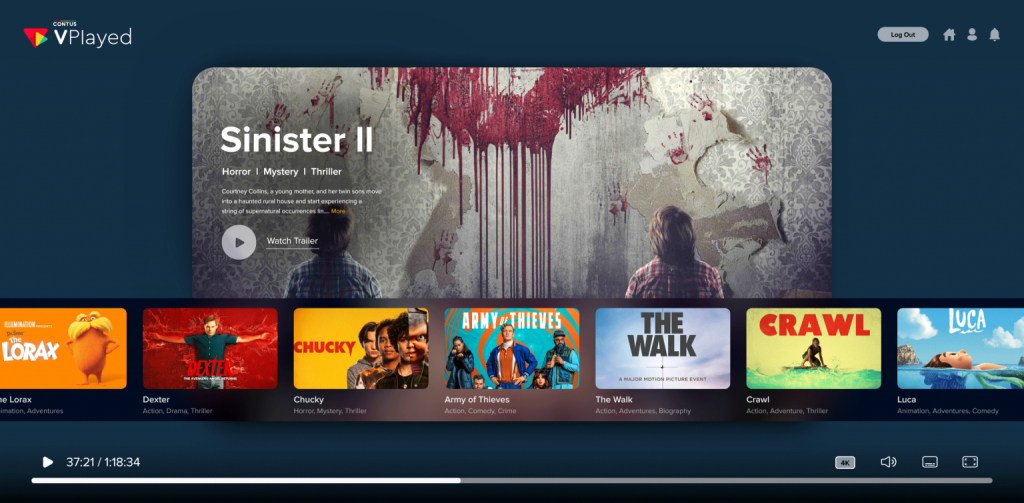
Streaming refers to the transmission of data from the storage device to another device through the internet. Data includes audio, video, images, and any other visuals. Streaming allows a smooth playback experience as the data is transmitted while a user is playing the video.
Video streaming has taken the world by storm in recent years. Be it in entertainment, education, brand building, customer engagement, or customer support. Video increases the chances of a prospective customer’s purchase by 40% and 96% of people watch a video to understand a product or service.
This blog provides the information about what video streaming is, how video streaming work, and why it outpaces downloading in speed, flexibility, and convenience.
Table of Contents
What is Video Streaming?
Video streaming is the process of transmitting video files over the internet in real-time, allowing users to watch movies, shows, or live streams without downloading, using media servers to deliver playback across mobile phones, smart TVs, and desktops.
Content is sent in a compressed format to the user’s device during data transmission. The user requires a video player to uncompress the video and prepare it for watching. In the best online video streaming platform, the video that the user uses uncompresses the audio, video, and text files.
How does Video Streaming Work?
Streaming video works by compressing video and audio files, stored on a remote server, then transmitted over the internet and sent to the requesting device to playback content in real-time without downloading, using buffering and adaptive bitrate streaming technology.
This process, known as cloud streaming, ensures seamless delivery by breaking the video file into streaming audio and video data packets containing bite-sized data.
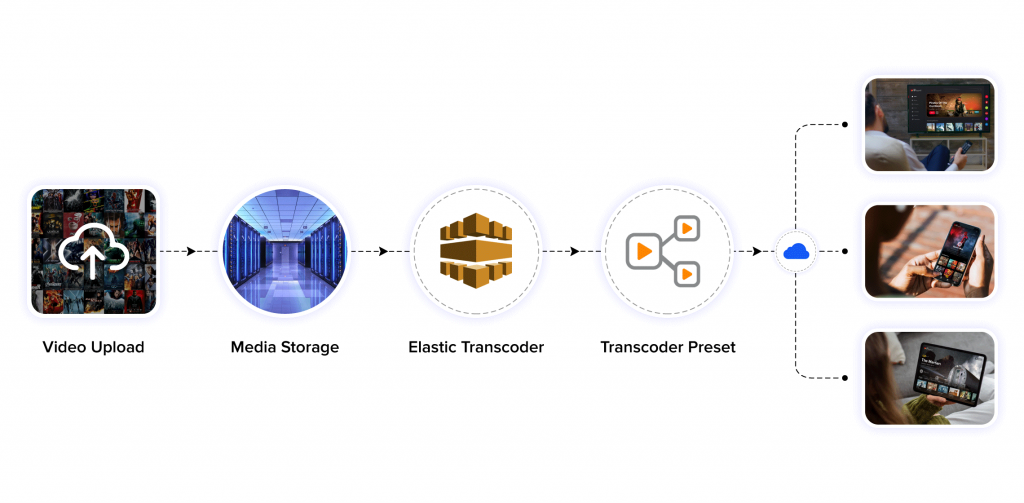
A transmission protocol like User Datagram Protocol (UDP) or Transmission Control Protocol (TCP) is made use of to transmit data over a network. The user needs to have a high internet speed for data to be transmitted easily so that the video can be watched without any buffering. If the user opts to watch the video at a lower quality, medium-speed internet is sufficient.
But for high-quality videos, high speed is mandatory, failing which the transmission of data will be interrupted, affecting the user experience.
What Are The Advantages Of Video Streaming?
Streaming video may offers many advantages like instant access to an on-demand vast library of content, movies and shows, delivering high-quality playback at lower costs than traditional cable networks, the flexibility to view content live or recorded, often with personalized recommendations, minimal ads, and exclusive programming that enhances user experience and audience engagement.
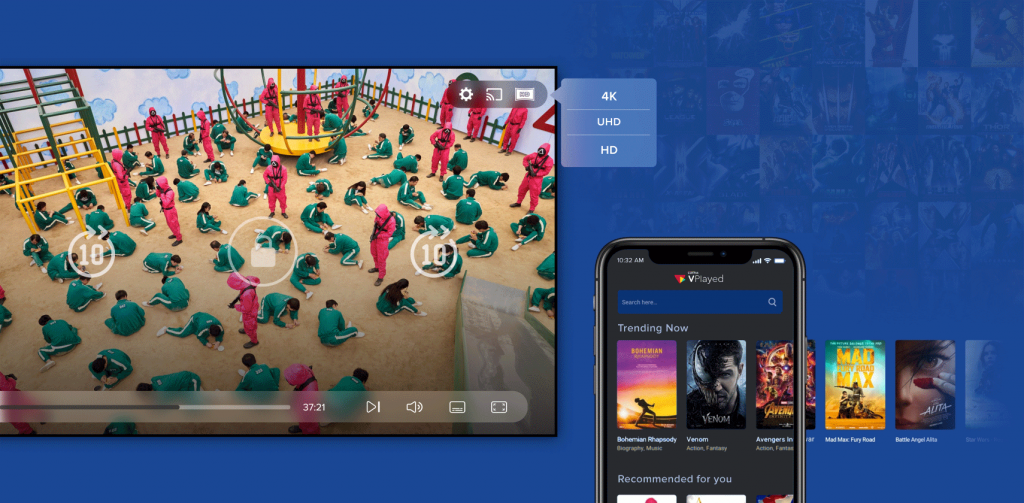
1. Downloading Vs Streaming
With Video streaming, there is no need to download a video to watch it. When the user hits the ‘play’ button of a hosted streaming, the video content is streamed by the process explained above. Some allow users to download a video in addition to watching it.
2. High-resolution Videos
Video streaming can choose to offer more than one resolution for the videos on their website/app for the users to choose from. In such a case, high-resolution videos require faster internet connectivity to stream videos seamlessly and low-resolution videos can be streamed even at a low internet speed.
3. Reduced Cost And Piracy
Streaming video delivers on-demand and live video content to their audience globally. Users no longer have the need to download pirated videos of television shows and movies to watch it. Low subscription charges to build a streaming app encourage people to watch it. This has reduced piracy and the cost of protecting the videos.
4. Cloud Storage
Any entertainment house that wants to go digital does not have to worry about investing in physical servers. All the data is stored on cloud streaming video server. Storage is expandable at any time and it is available at a reasonable cost. There is no involvement of investment and maintenance of servers for the storage of data.
5. Instant Access
Cloud-storage makes it easy for the business to stream video content to its users. Video Streaming can have virtual servers near the targeted geographic location for quick and easy streaming. This improves customer experience and there is no cost associated with it.
6. Easy Access To Content
Video content that you want to stream on your website can be stored on any virtual server throughout the globe. Since the Cloud servers can be accessed by anyone anytime from any part of the world, it becomes easy to manage your streaming video.
Looking To Build Your Own Online Video Platform?
Start and Grow Your Video Streaming Service With 1000+ Features & 9+ Revenue Models.
Highly Customizable
Life Time Ownership
Own 100% of Your Revenue
Full-Branding Freedom
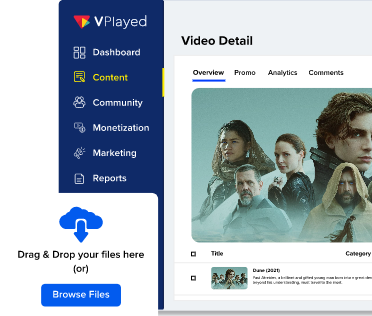
Key Challenges that Video Streaming Faces in the Current Market
Video streaming faces several challenges like buffering delays, latency issues, and fluctuating video quality due to unstable internet or network issues, along with problems like licensing restrictions, content delivery hassles, device compatibility concerns, and high data consumption, which can negatively impact user experience and concern for users with limited plans.
1. Lack of Bandwidth
Videos with high resolution and large bandwidth set new challenges. Consequently, bandwidth limitation has severely resulted in net neutrality, impacting on the quality of video content that consumers watch.
2. Slower Performing
Video streams may begin to slow down or drop out if a device is older, is slowed down by apps that aren’t designed for it, or has too many processes running at once. As a result, consumers encounter challenges such as video lags during the playback.
3. Copyrights
Users of white label streaming video content, particularly live streams, should be mindful of copyrighted content restrictions, such as music, that may appear in their broadcast. At the time of professional online broadcasting password protection & other encryption practices are essential.
4. Device Compatibility
Device compatibility is another major criteria for delivering with video services. Streaming video services must build streams in an adaptable way for a variety of devices in the market. It becomes quite difficult for service providers to capture one set of audience devoted to a single screen.
5. Network Latency
Massive amounts of data are supplied with increasing resolutions and bitrates, and this volume of activity might cause latency and reliability difficulties. The location of clients and servers on the network might affect latency. The greater the distance between the client & server, the longer the data must travel.
6. High Cost
The high cost is a big issue for streaming video firms. To create high-quality, original content, businesses must define video streaming with its core quality by investing in a significant amount of money. The key drivers to the rising expenses of streaming video services are cloud hosting, content delivery, and content generation.
How Is Video Streaming Different From Downloading?
When we define streaming video it means, the entire parts of videos are encoded, transmitted, and decoded. Furthermore, what really does matter here, focuses on the streaming process. The user plays a part of the video where minimum load time is taken when a video is buffered & gets to watch them at a click of a button.
On the other hand, during the time of downloading, the entire video file on the user’s device is downloaded for it to be played. Only then the viewer can access the file, however, in the case of video streaming is loaded in chunks rather than as a whole.
How Can You Use Different Technologies to Improve Video Streaming?
To improve streaming video quality, you need to have a robust, high-speed internet connection, finetune transcoding, select optimal resolution and bitrate, utilize updating bitrate streaming, upgrade streaming hardware, choose reliable CDNs’ and leverage a video hosting platform to deliver smooth, high-quality playback across all devices like mobile phones, computers, and smart TVs.
1. Transcoding
The process of re-encoding an existing video file into different file formats is known as video transcoding. To put it another way, this means that various copies of variable quality are made. This makes it possible to accommodate a wide range of bandwidth conditions as well as playback on numerous devices.
2. Adaptive Bitrate Streaming
The player identifies the end user’s internet connection and broadcasts the optimum video quality via adaptive bitrate streaming. This is something that the ABR technology can detect & elucidates its definition & sends an HQ stream instantaneously. As a result, there is little buffering which ensures a smooth viewing experience.
3. HTTP Live Streaming
When focusing on how video streaming works and what’s the basic protocol that it carries to stream, talks about HTTP. To serve online content, it makes it very compatible with video playback. Videos can be effortlessly streamed from any HTTP server and played with ease using any HTML5 player.
4. Content Delivery Network (CDN)
If you wish to stream content to huge audiences in multiple locations or who are far away from where the video content is stored, a video CDN is recommended. It is a server located near the user that aids in reducing the distance between the user and the original server.
5. Storage
Organizations can now choose where video content is stored, which is often done by those with strict security and compliance needs. The flexibility of choosing videos to be stored in a centralized CMS, along with a robust enterprise video content management system, makes it a necessary solution for content management in its entirety to be streamed either on cloud or on-premises.
How To Create & Launch Your Own Video Streaming?
The video streaming market size globally is $419.03 billion in 2021. It is expected to generate a revenue of $932.29 billion globally by 2028. Any business that wants to build a video streaming website that is successful should have an attractive website and app that is developed using the latest technology which caters to the needs of its target audience.
It is equally important to pick the right monetization method for streaming video and provide a top-notch user experience. There are multiple players in the market. You don’t want to do all the work and miss out on user experience only to see all your users migrate to your competitors. Do you?
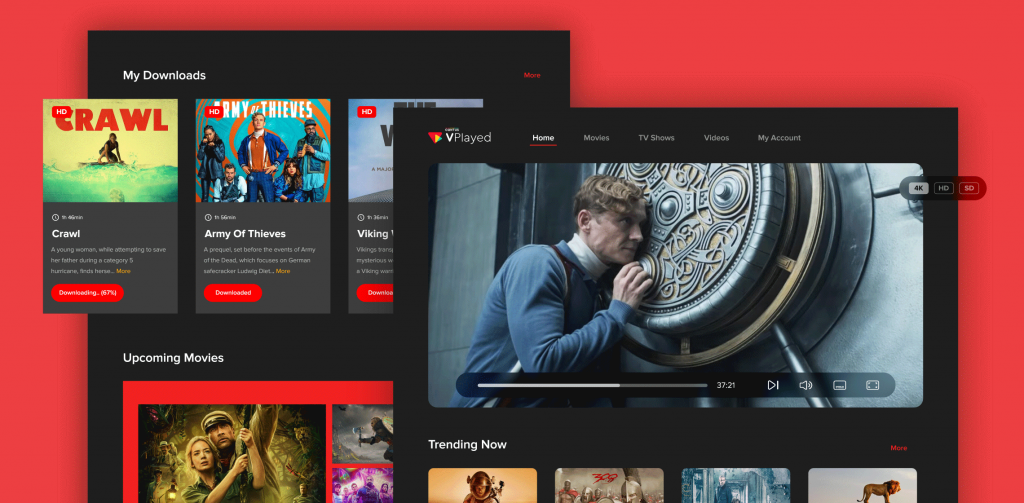
What Are The Key Features Of A Successful Video Streaming?
The best streaming video features are high-quality video and audio playback, adaptive bitrate streaming for seamless playback, live chat and polls for real-time interactions, secure content protection, personalized recommendations, live streaming, multi-device access, offline viewing, intuitive UI/UX, real-time analytics, and payment gateway integrations to enhance the user experience.
1. Cloud Hosting And On-premise Hosting
Most of the companies prefer to host their data on the cloud, yet there are a few companies who prefer hosting on-premise. A online video hosting should provide both options to the companies.
2. Third-party Service Integration
Every feature and service that you want your video streaming to have does not have to be built from scratch. You can utilize a streaming app development programming interface (API) to integrate third-party tools and programs into your app to provide an exceptional user experience.
3. In-built Video CMS
Content presentation is as important as having in-demand content when creating a streaming website. An in-built OTT CMS platform acts as a powerful video content management system, organizing content by category, language, preference, and other parameters. This helps users navigate and choose the video content they want to watch.
4. HLS Video Player
HTTP live streaming is also termed as HLS video player. It is a tool that businesses can use to deliver audio and video to a large audience segment through the Internet. It can stream video content to any device including a television set and smart tv like Roku & Android TV app etc. It has low latency and high speed, thereby catering to a widespread audience.
5. Multiple Monetization Models
Monthly and yearly subscription plans are the most popular video monetization plans for any streaming video. This has gained widespread acceptance and popularity amongst people across the globe because users can choose when and for how long they want to pay. Free trial is something all viewers look out for before they decide to invest as a subscriber. So, don’t forget the free trial.
6. Security
Video security is of paramount importance when it comes to user data. Contact details and payment details of all your subscribers have to be secure. With cyber-crimes rising in 2021, investing heavily in data security is becoming all the more important, especially for platforms relying on VOD hosting, where large volumes of user data and premium content must be protected end-to-end.
7. Video Marketing
Video marketing is an integral part of any marketing strategy these days. Be it on social media, e-mail marketing or on websites, videos play an integral role in user engagement. Users tend to watch videos more when compared to other mediums of engagement.
8. Video Analytics
Video Analytics gives your business a complete picture of your user behavior. You can analyze your users on different parameters to gain a complete understanding and work towards framing strategies to maximize user engagement.
Conclusion
Now that you know all the technicalities and benefits of streaming videos, you can build a VOD website and create the best video streaming services from scratch. Narrow down on the target audience you want to serve, use the latest technology for the killer software, and provide an exceptional user experience. Your streaming website will be on top of the charts in record time.
- Request Demo Book a Live, Personalized Demo
- Contact Sales Reach Out to Our OTT Experts
Frequently Asked Questions (FAQ):
1. Why Is Streaming video Important For Your Business?
Professional-grade video streaming provides a great value while investing since consumer-grade solution aren’t capable of satisfying needs of large businesses. When it comes to video streams, they are cloud-based and provide advanced features like cutting-edge tech-stack, 6+ monetization models, everlasting ownership, robust CMS, first-class security, etc.
2. What Are The Different Types Of Video Streaming?
As global trends have been influencing consumer viewing habits the definition of streaming video sets to expand across wide range of niches. The media content is in the form of live or recorded streams, which are delivered to web, mobile or varied connected devices. Some of the common forms of streaming content are webcasts, podcasts, movies, TV shows, etc.
3. What Are The Benefits Of Streaming Video?
Some of the benefits that streaming businesses can own comprise of downloadable content at any circumstance, rendition of videos at flexible resolutions, reduced cost due to increased accessibility of the streaming, data storage is not with physical servers but on cloud, enhanced customer experience due to flexible options in playback, etc.
4. How To Start A Video Streaming Business?
While you tend to own up streaming videos you can set your revenue model to rapidly increase streaming ROI. Also you can leverage on the facility of centralized storage, ensure flexible payment gateways, choose a standard embed player, get network of server connected to each other for smooth delivery of content, instill security paywalls, & much more.
5. How Do I Monetize Video Content?
You can now independently stream & monetize on demand as well as live streaming content with major monetization models like Subscription VOD, Advertising VOD, Transactional on demand, Premium VOD, Video Paywalls, Coupons & promotions & lots more.
